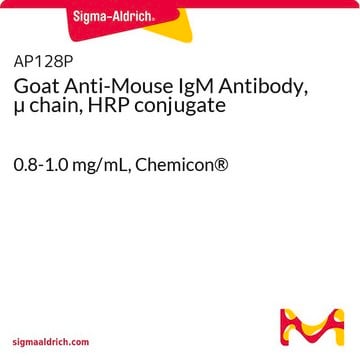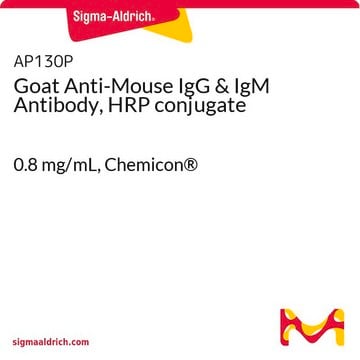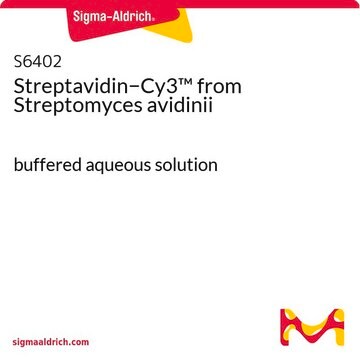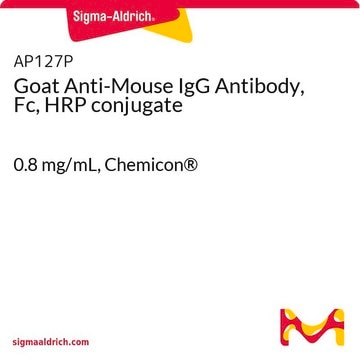AP500R
Goat Anti-Mouse IgM µ chain Antibody, Rhodamine conjugate, Species Adsorbed
1 mg/mL, Chemicon®
Sign Into View Organizational & Contract Pricing
All Photos(1)
About This Item
UNSPSC Code:
12352203
eCl@ss:
32160702
NACRES:
NA.46
Recommended Products
biological source
goat
Quality Level
conjugate
TRITC conjugate
rhodamine conjugate
antibody form
affinity purified immunoglobulin
antibody product type
secondary antibodies
clone
polyclonal
species reactivity
mouse
manufacturer/tradename
Chemicon®
concentration
1 mg/mL
technique(s)
ELISA: suitable
immunofluorescence: suitable
shipped in
wet ice
target post-translational modification
unmodified
General description
IgM constitutes about 10% of serum immunoglobulins. IgM antibody is prominent in early immune responses to most antigens and predominates in certain antibody responses such as ′natural′ blood group antibodies. IgM (with IgD) is the major immunoglobulin expressed on the surface of B cells. The gene for the mu constant region contains four domains separated by short intervening sequences.
Specificity
Reacts with heavy chain of mouse IgM. Absorbed for mouse IgG1, IgG2a, IgG2b, IgG3 and IgA, pooled human sera and purified human paraproteins. Minimal cross reactivity with human immunoglobulins. Reactivity with other species has not been determined.
The antibody reacts with the heavy chain of mouse IgM as demonstrated by ELISA and flow cytometry. Minimal cross reactivity with human immunoglobulins.
Immunogen
Epitope: IgM µ chain
Prepared from purified mouse IgM µ chain. Pooled antisera from goats hyperimmunized with mouse IgM paraproteins.
Application
Detect Mouse IgM µ chain using this Goat anti-Mouse IgM µ chain Antibody, Rhodamine conjugate, Species Adsorbed validated for use in ELISA & IF.
Immunofluorescence: ≤1 μg/106 cells.
ELISA
Optimal working dilutions must be determined by the end user.
ELISA
Optimal working dilutions must be determined by the end user.
Research Category
Secondary & Control Antibodies
Secondary & Control Antibodies
Research Sub Category
Secondary Antibodies Adsorbed for Dual Labeling
Fragment Specific Secondary Antibodies
Secondary Antibodies Adsorbed for Dual Labeling
Fragment Specific Secondary Antibodies
Physical form
Affinity Chromatography
Purified by affinity chromatography on mouse IgM covalently linked to agarose. Liquid in 1.0 mL PBS/NaN3.
Storage and Stability
Maintain refrigerated at 2°-8°C under sterile conditions for up to twelve months from date of receipt. Do not freeze.
Legal Information
CHEMICON is a registered trademark of Merck KGaA, Darmstadt, Germany
Disclaimer
Unless otherwise stated in our catalog or other company documentation accompanying the product(s), our products are intended for research use only and are not to be used for any other purpose, which includes but is not limited to, unauthorized commercial uses, in vitro diagnostic uses, ex vivo or in vivo therapeutic uses or any type of consumption or application to humans or animals.
Not finding the right product?
Try our Product Selector Tool.
Storage Class Code
10 - Combustible liquids
WGK
WGK 2
Flash Point(F)
Not applicable
Flash Point(C)
Not applicable
Certificates of Analysis (COA)
Search for Certificates of Analysis (COA) by entering the products Lot/Batch Number. Lot and Batch Numbers can be found on a product’s label following the words ‘Lot’ or ‘Batch’.
Already Own This Product?
Find documentation for the products that you have recently purchased in the Document Library.
Claudia Landi et al.
Journal of neuroscience research, 98(4), 718-733 (2019-12-05)
In Krabbe disease, a mutation in GALC gene causes widespread demyelination determining cell death by apoptosis, mainly in oligodendrocytes and Schwann cells. Less is known on the molecular mechanisms induced by this deficiency. Here, we report an impairment in protein
Yuan Li et al.
International journal of oncology, 52(6), 2119-2129 (2018-04-06)
An intratumoral hypoxic microenvironment is frequently observed in solid tumors, including breast cancer. Lutein, a plant-derived compound and non-vitamin A carotenoid, has been demonstrated to possess multiple protective properties including anti-inflammation, anti-oxidative stress and antitumor effects. The main objective of the
Our team of scientists has experience in all areas of research including Life Science, Material Science, Chemical Synthesis, Chromatography, Analytical and many others.
Contact Technical Service







